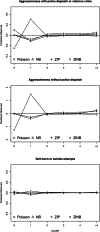Influencing factors of multiple adverse outcomes among schizophrenia patients using count regression models: a cross-sectional study
- PMID: 35840915
- PMCID: PMC9284775
- DOI: 10.1186/s12888-022-04070-3
Influencing factors of multiple adverse outcomes among schizophrenia patients using count regression models: a cross-sectional study
Abstract
Background: Schizophrenia patients have increased risks of adverse outcomes, including violent crime, aggressiveness, and suicide. However, studies of different adverse outcomes in schizophrenia patients are limited and the influencing factors for these outcomes need clarification by appropriate models. This study aimed to identify influencing factors of these adverse outcomes by examining and comparing different count regression models.
Methods: This study included schizophrenia patients who had at least one follow-up record in the Guangdong Mental Health Center Network Medical System during 2020. Three types of adverse outcomes were included: a) aggressiveness with police dispatch or violent crime, b) aggressiveness without police dispatch, and c) self-harm or suicide attempts. The incidence density of these adverse outcomes was investigated using the Poisson, negative binomial (NB), zero-inflated Poisson (ZIP), and zero-inflated negative binomial (ZINB) models, accordingly. The best model was chosen based on goodness-of-fit tests. We further analyzed associations between the number of occurrences of adverse outcomes and sociodemographic, clinical factors with the best model.
Results: A total of 130,474 schizophrenia patients were enrolled. Adverse outcomes rates were reported to be less than 1% for schizophrenia patients in 2020, in Guangdong. The NB model performed the best in terms of goodness-of-fit and interpretation when fitting for the number of occurrences of aggressiveness without police dispatch, whereas the ZINB models performed better for the other two outcomes. Age, sex, and history of adverse outcomes were influencing factors shared across these adverse outcomes. Higher education and employment were protective factors for aggressive and violent behaviors. Disease onset aged ≥ 18 years served as a significant risk factor for aggressiveness without police dispatch, and self-harm or suicide attempts. Family history of mental diseases was a risk factor for self-harm or suicide attempts individually.
Conclusions: NB and ZINB models were selected for fitting the number of occurrences of adverse outcomes among schizophrenia patients in our studies. Influencing factors for the incidence density of adverse outcomes included both those shared across different types and those individual to specific types. Therefore, comprehensive and customized tools in risk assessment and intervention might be necessary.
Keywords: Aggressiveness; Count model; Influencing factor; Schizophrenia; Suicide attempt; Violent crime.
© 2022. The Author(s).
Conflict of interest statement
The authors declare that they have no competing interests.
Figures


Similar articles
-
Study of Zero-Inflated Regression Models in a Large-Scale Population Survey of Sub-Health Status and Its Influencing Factors.Chin Med Sci J. 2017 Dec 30;32(4):218-225. doi: 10.24920/J1001-9294.2017.054. Chin Med Sci J. 2017. PMID: 29301596 Clinical Trial.
-
Statistical modelling of falls count data with excess zeros.Inj Prev. 2011 Aug;17(4):266-70. doi: 10.1136/ip.2011.031740. Epub 2011 Jun 8. Inj Prev. 2011. PMID: 21653652
-
A comparison of statistical methods for modeling count data with an application to hospital length of stay.BMC Med Res Methodol. 2022 Aug 4;22(1):211. doi: 10.1186/s12874-022-01685-8. BMC Med Res Methodol. 2022. PMID: 35927612 Free PMC article.
-
Comparison of linear and zero-inflated negative binomial regression models for appraisal of risk factors associated with dental caries.J Indian Soc Pedod Prev Dent. 2016 Jan-Mar;34(1):71-5. doi: 10.4103/0970-4388.175521. J Indian Soc Pedod Prev Dent. 2016. PMID: 26838152 Review.
-
[Preventing violence in schizophrenia with cognitive remediation].Encephale. 2018 Apr;44(2):158-167. doi: 10.1016/j.encep.2017.05.001. Epub 2017 Jun 20. Encephale. 2018. PMID: 28641817 Review. French.
References
-
- Global Health Data Exchange. GBD Results Tool. Available from: http://ghdx.healthdata.org/gbd-results-tool. Accessed 13 May 2021.
Publication types
MeSH terms
LinkOut - more resources
Full Text Sources
Medical

